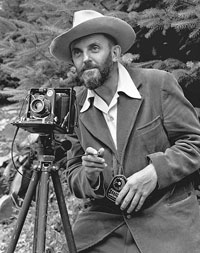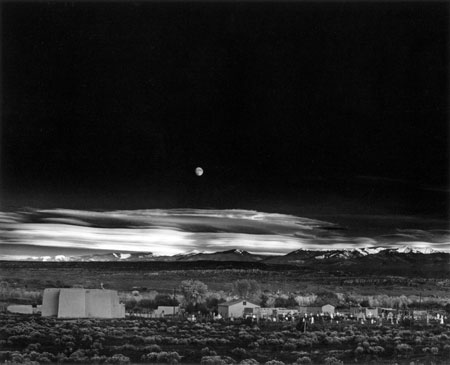Rediscovered Ansel Adams video shows rare footage of the master photographer at work
posted Thursday, August 16, 2012 at 3:22 PM EST
 Ansel Adams changed the way photographers look at the natural world and the way we take scenic photographs. His “Zone System” certainly changed the way many of us took and printed black-and-white photographs. I know beause I studied the system with one of Ansel’s printers, Oliver Gagliani, and it definitely improved my prints and my photography.
Ansel Adams changed the way photographers look at the natural world and the way we take scenic photographs. His “Zone System” certainly changed the way many of us took and printed black-and-white photographs. I know beause I studied the system with one of Ansel’s printers, Oliver Gagliani, and it definitely improved my prints and my photography.
An old video about Adams has gotten a new life on YouTube, generating renewed interest in this American master. The Ansel Adams video, embedded at the bottom of this story, is taken from a film made in 1958 by Beaumont Newhall, then the curator of the George Eastman House, and his wife Nancy.
Entitled, plainly, "Ansel Adams—Photographer Pt.1," the film is in a style reminiscent of Edward R. Murrow’s See It Now. It presents Adams as a classical pianist, a writer, and a visionary.
While it's an interesting look at Adams with some rare footage of the master at work, it shows its age. What it misses is that while Adams was a great photographer, he was also a great marketer. He not only sold lots of beautiful prints, he was an early Sierra Club member who literally changed the way we see and think about the wilderness.
Early years
Born in 1902 into a wealthy San Francisco family, Ansel Easton Adams was a precocious child who taught himself to play piano by age 12. In 1916, when the Adams family visited Yosemite National Park, the young Ansel described it as, "the splendor of Yosemite burst upon us and it was glorious...One wonder after another descended upon us... There was light everywhere... A new era began for me."
For this holiday, Adams’ father gave him a Kodak Brownie box camera, and the 14-year-old immediately began taking photographs with his, “usual hyperactive enthusiasm."
In the 1920s, Adams began to sell his Yosemite prints and in 1928 after marrying the daughter of the owner of Best’s Studio in the Park, ran it as a studio/gallery, selling and showing his Yosemite images.
Even those early Adams prints were very different from the standard scenic photographs of his day. In the early 20th century, photography was dominated by the belief that the only good photograph was a manipulated one. Every photograph had to be blurred, soft focused, hand colored, or otherwise altered to be interesting.
Adams rejected that and printed sharp, crisp, prints full of detailed highlights and rich shadows. In 1932, along with photographers like Edward Weston, and Imogen Cunningham, he was part of “Group f/64” who promoted a modern approach to photography, emphasizing sharpness, large depth of field and overall image clarity.
Of the f/64 photographers, Adams became the most recognized and by far the most successful. While Weston and others saw themselves as free spirits, Adams was more conservative.
He loved playing Bach and studied the ideas of 19th century “Romanticism” that said that nature in all her awesome power ought to be embraced and experienced deeply, rather than feared. Or as Adams put it, "I believe in beauty. I believe in stones and water, air and soil, people and their future and their fate."
Accessible & direct
Romanticism wasn't just some poetic philosophy. In America, it was part of the notion of Manifest Destiny, the nation’s westward expansion. By the late 19th century, the frontier was gone and few wild places remained.
For me this is the key to Adams’ success as he blended modern photographic techniques with this romantic philosophy. His images are of what was left of the American wilderness. His dramatic black-and-white prints, so richly printed that they seemed otherworldly, reinforce the value of wilderness.
Adams’ photographs are always accessible to the viewer and direct. There is no mystery about these pictures; they are not self-referential art and there is no hint of irony.
I think they also became so popular because underneath the Romanticism there is a religiosity. Part of manifest destiny was the idea that God had given America its vast land.
Adams photographs illustrate the moment of the “sublime,” that feeling of being in the presence of God, or creation. I can see it in many Adams photographs. The viewer is looking up at the vastness of mountains and sky. In images like Moonrise, Hernandez, New Mexico, (1941) -- below -- there is a church like stillness of moonlight over a small village graveyard.

For photographers though, whatever his subject, it is always his prints themselves that astonish. I remember the first time I saw an Adams print and how I just stood there in awe.
Imogen Cunningham's prank
The YouTube video is a respectful presentation of this romantic acolyte. Narrated by Beaumont Newhall, who speaks in a deep, resonated voice, it was almost as though we were hearing a minister preach the blessings of pre-visualization and the Zone System.
Adams appears working in his darkroom looking like nothing less than a medieval monk, fussing about in some sort of alchemist’s laboratory.
There is no denying Adams’ impact and he was one of the first photographers to realize the potential for mass marketing his photographs by using them in calendars, books, traveling photo shows and in advertising.
I was lucky enough to have met one of the Group f/64 photographers, Imogen Cunningham, back in the 1970s. She was in her 90’s and I had a chance to ask her about f/64 and Adams.
Cunningham had been a good friend and neighbor of Adams’, but she now felt that he had sold out, over-commercializing his images. It upset her and when he sold a photo to the Folgers coffee company, for a coffee can wraparound, she decided to show him her displeasure. She bought one of the “Yosemite” cans, filled it with soil from her garden, and planted some seeds in it.
She then gave it to Adams as a gift, instructing him to put it the sunny windowsill in his music room. Adams followed her instructions, watered the soil, and soon had a large bushy plant.
Recalling that moment Cunningham began to laugh and said, “The poor dear was so naïve. He was shocked when a friend told him he’d better get rid of it because what I had given him was marijuana plant.”
In the opening sequence of Ansel Adams-Photographer Pt.1, if you look just beyond Adam’s piano you can see that windowsill.